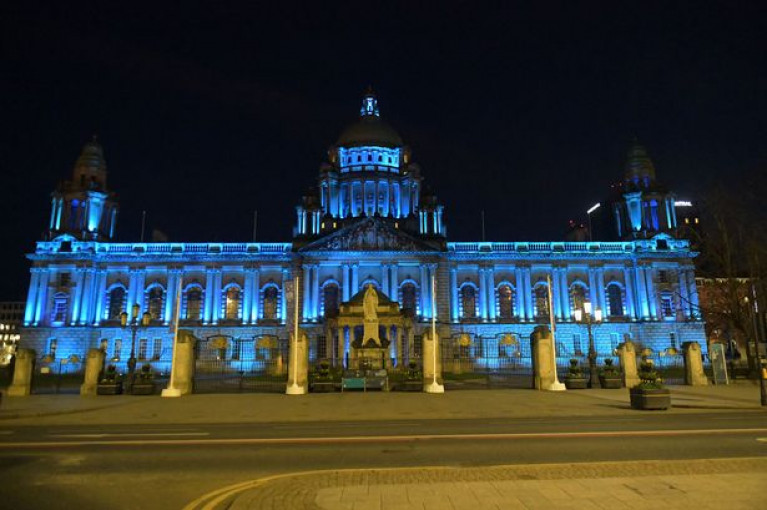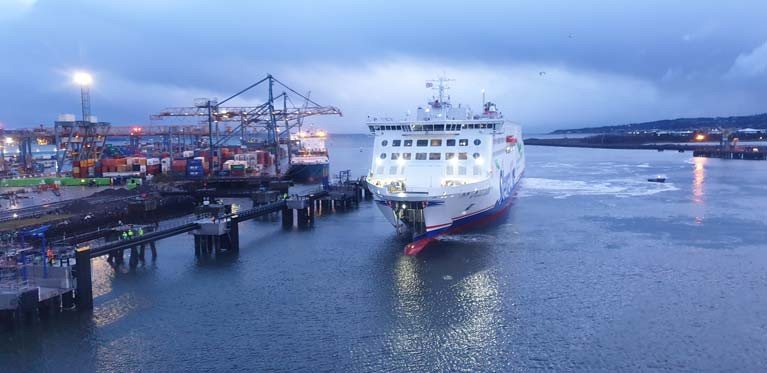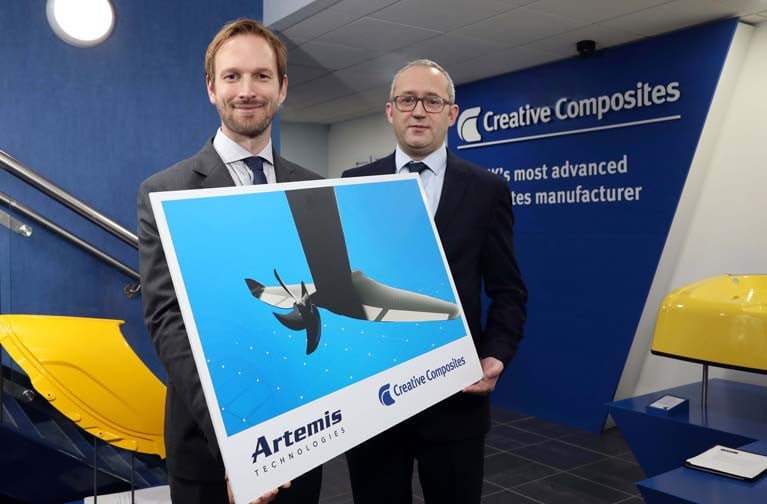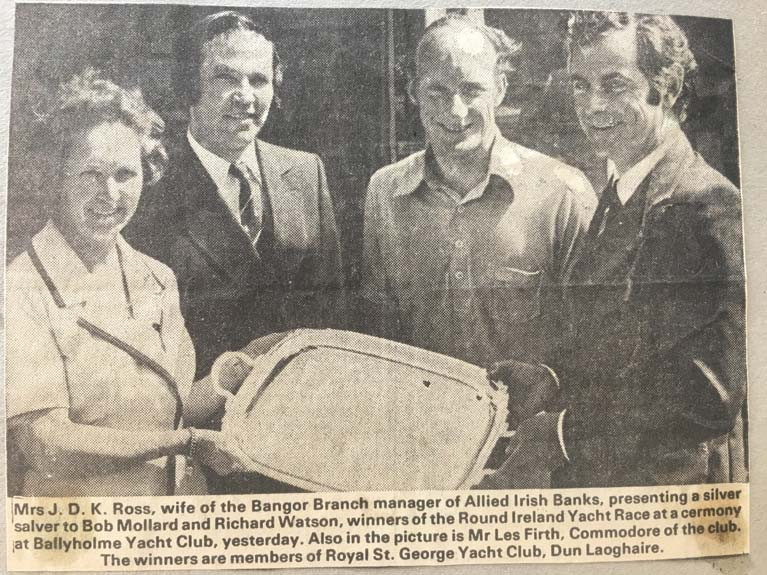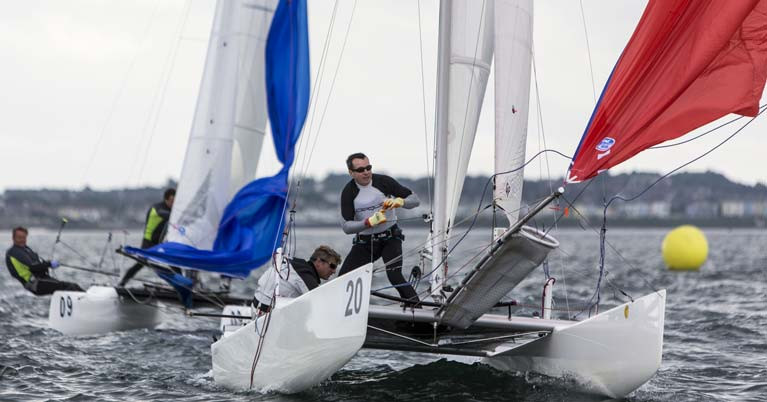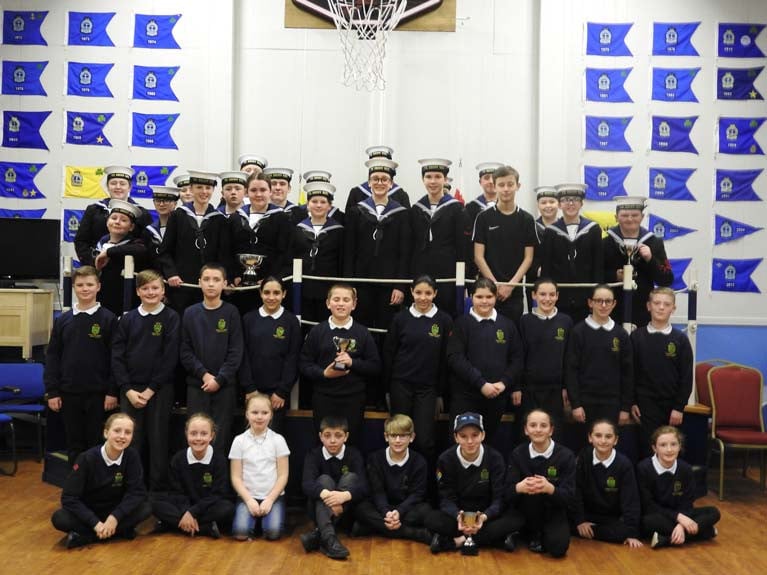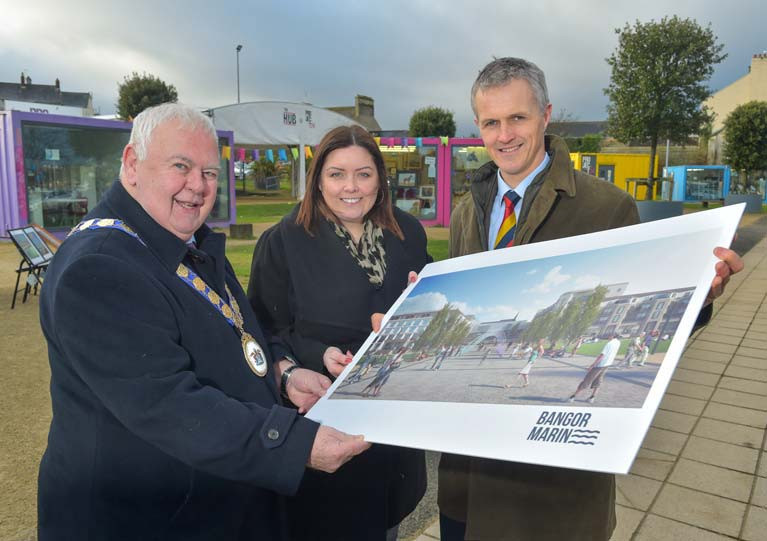Displaying items by tag: Belfast Lough
Boatbuilding at Ballyholme on Belfast Lough
Betty Amstrong explores past boatbuilding ventures in Ballyholme in the seaside town of Bangor on Belfast Lough.
Did you know that before Enrico Caproni built his famous ‘Palais de Dance’ in 1928 on Seacliff Road that there was a shipyard on that site on the corner of Seaforth Road?
In fact, there were two businesses carrying out shipbuilding and associated work in Ballyholme. In March 1919 Chesney McCormick and Francis J B Connolly together applied for permission to build a ‘Workshop or shed of brick, roofed with slates’ on the west side of Seacliff Road. Connolly was an architect and civil engineer and the 1911 Census shows he lived on Bryansburn Road when he was 23. There are also reports of him being elected as a student member of the Ulster Society of Architects in 1906. In December 1919 McCormick lodged plans for a temporary ‘Boat house and Spar shed’ on Seacliff Road near College Gardens, a terrace part of which became the Ballyholme Hotel.
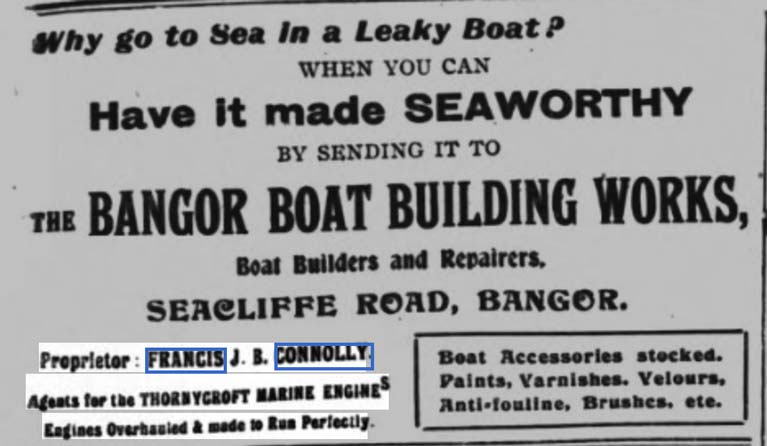 An advertisement from the North Down Herald of 2nd Nov 1920
An advertisement from the North Down Herald of 2nd Nov 1920
In 1920 and 1921 Connolly was advertising under the name Bangor Boat Building Works and in April 1923 McCormick and the Bangor Boat Building Works applied to build a ‘Wooden shop and dwelling’ on the south side of Seaforth Road. The launching slip for the yard was opposite and can still be seen today beside Ballyholme Yacht Club.
 McCormick's Yard in the 1920s
McCormick's Yard in the 1920s
Pictorial records show that McCormick & Co had a shed where Kingsland Nursing Home is today, and this appears to be the location where the Shipyard business carried on into the future. It provided winter storage for the local racing yachts such as Dancers and Rivers and for yachts and motorboats up to 20 tons and built a launching slip opposite. It had a distinctive curve and is still there today. McCormick & Co didn’t last long and on 30th October 1924, the business was advertised for sale. The reason for the demise can be seen in a letter of reference from McCormick & Co in the Public Record Office in respect of a Robert Eddys of Ballymagee Street (High Street) Bangor, which shows that he was an ex-seaman and a rigger and was dismissed owing to shortage of work. The date is 24th October 1924.
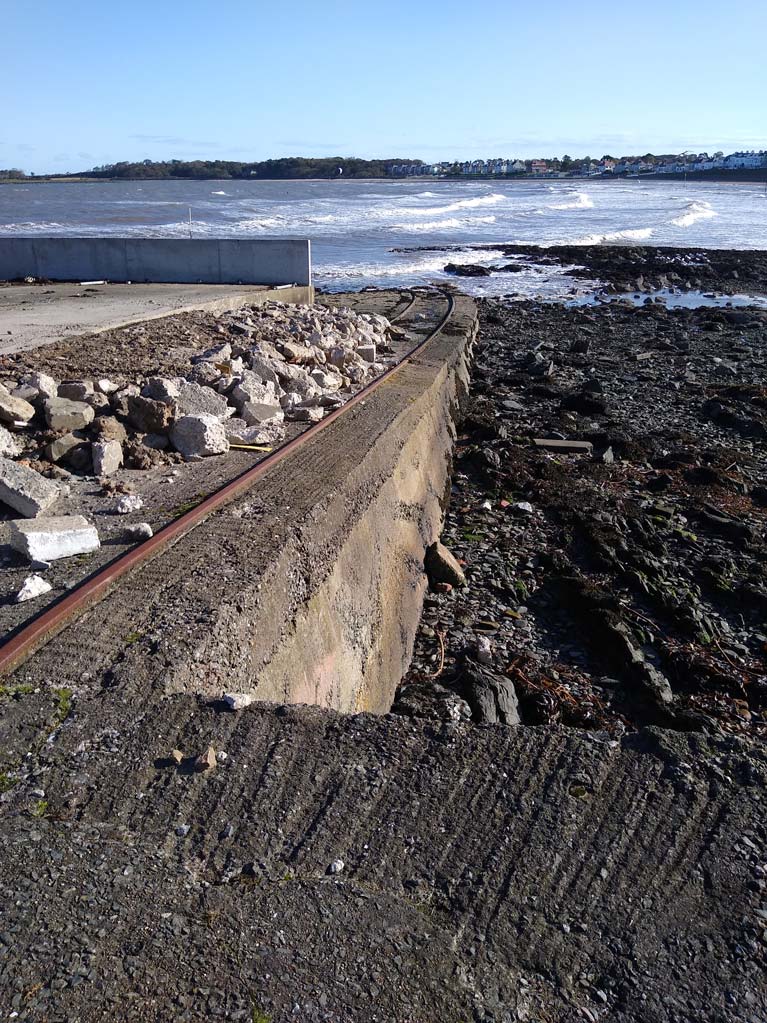 The old slipway at Ballyholme
The old slipway at Ballyholme
Enrico Caproni may have foreseen the demise of the business on the corner of Seaforth Road for in June 1923 he submitted plans for ‘Refreshment Rooms and a temporary shop’. The Bangor Boat Building Works faded from record, but it is known that the slip was transferred to the sailing club at Ballyholme which at the time met in the clubhouse on Kingsland which is now the Table Tennis club. The slip can still be seen today at low tide.
 Lovetts Shipyard Ltd showing Rivers in winter storage
Lovetts Shipyard Ltd showing Rivers in winter storage
The McCormick business was bought by a Mr. W J Lovett, who was one of the Senior Naval Architects and a Director in the Workman Clark & Co shipyard in Belfast. He called the business The Shipyard Company Ltd and in 1925 added a store. By this time Caproni had his café which he called the Mirimar.
In 1926 Mr Lovett asked Robert (Bertie) Slater, a naval architect in Workman Clark’s, to manage the yard. Prior to the liquidation of the company McCormick was building yachts of the Dancing class for Royal Ulster Yacht Club.
The completion of two Dancing Class yachts which had been abandoned was Bertie Slater’s first job. The yard also built ships lifeboats for the Port Line whose liners were being constructed by Workman Clark.
In 1930 the yard built one of the largest boats, a 50 ft passenger-carrying cabin launch for the Lough Erne Boat Co. It made the passage to Belfast under its own power and was then lifted onto a special railway truck and transported to Enniskillen where it was launched into Lower Lough Erne. The shipyard also built six-cabin cruisers for Hyland Ltd and in 1934 a 35ft Motor Yacht, the Moya, for Mr Lovett and to his own design.
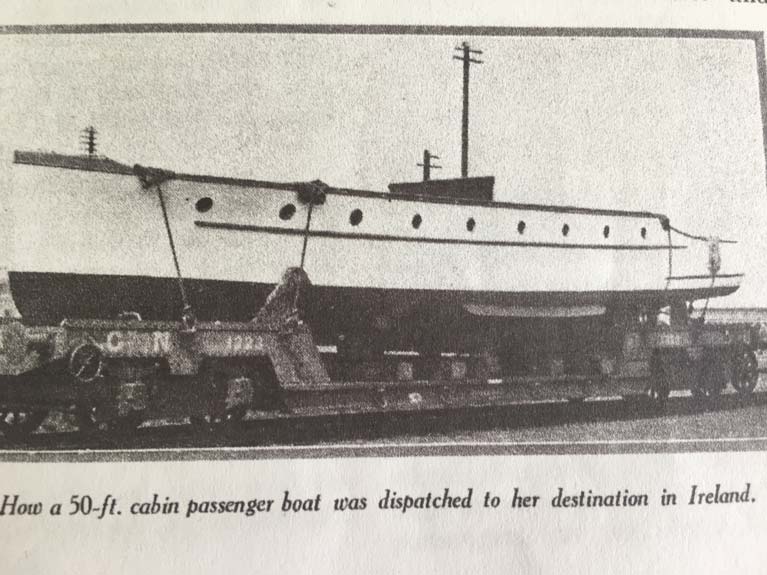 The 50 ft Passenger Launch for Lough Erne
The 50 ft Passenger Launch for Lough Erne
In 1932 Bertie Slater lodged plans for an ‘Iron Shed’. He had married and settled in Ballyholme in 1928 and by 1937 he owned the yard. The late Thirties was a time of slump and little money and the yard struggled to survive. During the war, the yard was very busy with Admiralty work. In addition to maintaining a large fleet of patrol boats and trawlers, the yard built Torpedo Recovery Boats for Lough Neagh. Some of the boats in Bangor had escaped from occupied Norway, Holland, France and Belgium.
Towards the end of the war, Slater built 50-foot-long flat-bottomed Scows for magnetic minesweeping and 36-foot Harbour Launches, some of which were used at Arromanches, one of the D Day beaches. He was also asked by the Admiralty if he could build 112-foot wooden Minesweepers. For this, he identified a suitable site at nearby Groomsport and requested a grant of £10k for a slip, shed, winch and machinery, but was refused. Years later he was told if he had asked for £100k he would have got it!
Slater’s upper yard had a large shed for boat building and repairs. The rest was used for Winter storage and Spring fitting out of yachts and motorboats. The fact that boats could be driven ashore from their moorings in the Bay in onshore gales, provided the yard with extra business for repairs.
Slater subsequently built a sheet metal workshop to cope with Ventilation Trunking for mills and factories. The shipyard installed the ventilation ducting in The Tonic Cinema in the late Thirties. A second building shed was constructed alongside the original shed to cope with RNLI repairs and maintenance.
After the war Slater designed the S Class cruiser, a superb affordable sailing yacht built in the traditional way by skilled craftsmen. The S-class boats are sturdy cruisers, well suited to Irish and Scottish waters. Many of these yachts are still sailing today.
In 1958 Bruce Cowley, who had retired from HMRC, bought the yard. Cowley continued the S Class production, making a total of 22 built in Bangor between 1946 and 1964. He also built well-known large cruising yachts; Jaynor for Ivan Selig built with the Fastnet race in mind, the famous Duncrue for Sean McNeill, and Trasna of Ely for the Duke of Westminster on Lough Erne.
In 1969 the yard was in receivership and Frank Smyth, who at this time owned a small boatyard in Donaghadee and a chandlery in Bangor, bought the business and for a time traded as Bangor Yacht Supply Co. In 1975 it became Bangor Shipyard Ltd. When Frank started the workshop had an earthen floor and very old equipment which he replaced with gear from the Donaghadee workshop.
His venture into boat building began with three small wooden punts and then with the introduction of fibreglass, Smyth made his own small dinghy moulds and began producing them. He subsequently shipped in fibreglass hulls from England and fitted them out. These he sold in the small chandlery in Bangor. The first big job in the Shipyard was repairing Velia for the well-known hotelier, George Ralston and the yard was also recognized for the repair of the Donaghadee, Aranmore, Cloughey and Portrush lifeboats. The lifeboat work was suspended by the RNLI for fear of terrorist action (this was during the Troubles) but Smyth grasped the opportunity and obtained the contract for repairing two pilot boats from Carrickfergus which were damaged by an explosion.
Up until this time Smyth had to lay rails in sections on the road on which to make the transfer from the yard to the slip, which took at least an hour. Frank approached the then Town Surveyor, Martin Gray, who persuaded the Council to allow rails to be embedded in concrete in the road to make the movement smoother and easier. On one notable occasion, the Seacliff Road had been blocked when the concrete rail bedding collapsed due to the fishplates not having been fitted properly!
Another improvement resulted from the purchase of a secondhand winch (which was to have been scrapped) from the Belfast aerospace company Short Bros for £25 and an ex RAF tractor bought in an auction for £100. Frank also acquired a hydraulic crane and for several years, Fred, the crane driver was in demand across the country for lifting boats.
Building and repairing fishing boats formed a substantial part of the business. This developed into a full-blown boat building business with a sizeable workforce. Many of the names will be familiar to seafarers – Elias Scott (Scottie) who was awarded a BEM, Willie Harvey, Ken Bewley, Jimmy Hamilton and Norman Henry. Government grants for fishing boats made the financial situation easier and this part of the yard flourished for about ten years. At this point Smyth was building larger fishing boats of 70 feet in length and to accommodate these he demolished the old shed and built a larger one. The maintenance and refurbishment of RNLI lifeboats also formed a large part of the business.
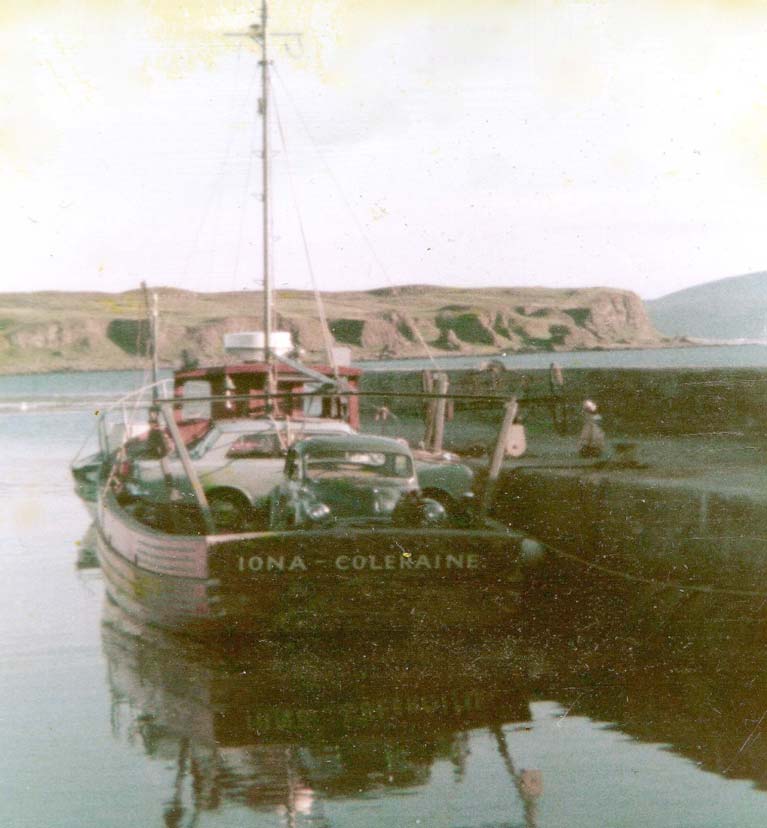 Iona car, cattle and caravan transporter
Iona car, cattle and caravan transporter
Among the many fishing boats Smyth fitted out was the 30-ton Ros Mor for local fisherman, the late Jack Miller. The Fragrant Cloud, Xmas Star and the Jubilee Star, the Sarna and the Iona were other craft among many. The latter was built for Tommy Cecil of Rathlin. It was the first fully decked ferry boat built for trade between Ballycastle and Rathlin. Subsequently, to Frank’s surprise, Tommy asked for the decks to be strengthened. It turned out he was carrying cattle, cars and caravans!
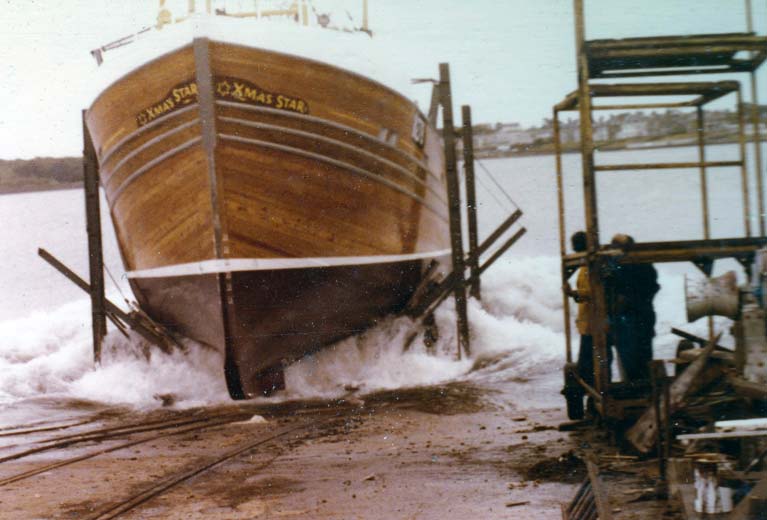 Launch of Xmas Star
Launch of Xmas Star
By this time the Government had built sophisticated slips at Kilkeel and Portavogie, wooden construction was diminishing, and grants were cut, all making boatbuilding difficult. Then came Bangor Marina. Smyth was invited to tender for the Bangor boatyard contract, but for him this was unworkable and as boatbuilding at Ballyholme was no longer viable and the yard closed in 1991.
The author acknowledges the help in gathering this information of Ronnie Slater, son of one of the owners and Frank Smyth, the last owner of the yard. Also, of Leanne Briggs of North Down Museum, and of the Public Record Office
Applause for Dockers, Hauliers, Stevedores & Harbour Police
The clapping for carers expression of support during the COVID-19 emergency was repeated at 8 pm last night across Northern Ireland and included applause for NHS workers, as well as the frontline staff who work in the docks – hauliers, stevedores and harbour police.
Ships sounded their horns, boosting the noise and Titanic Belfast, in its prominent location beside the River Lagan, and the City Hall were lit up in blue as a tribute the healthcare workers. It looks as if this expression of appreciation will be repeated weekly.
More from the Irish News here
The second Women on Water Festival will take place at Carrickfergus Sailing Club with Belfast Lough Sailability on 6 June 2020, bringing together women from right across NI as they take to the water.
The first festival was held in September 2019 and was a huge success. Around 50 women gathered at Strangford Lough Yacht Club, from first-timers to lifelong sailors.
The festival is open to like-minded women who have been involved in sailing from a young age or as part of the recent Women on Water programmes.
The Women on Water programme runs at clubs across Northern Ireland and sees women taking part in a four-week programme to learn the basics of sailing, as well as making new friends along the way. It is a low cost programme and is open to women of all abilities.
RYA Northern Ireland’s Active Clubs co-ordinator Lisa McCaffrey explains: “It is fantastic to now have the date for the next Women on Water Festival marked firmly in the diary. Last year was an uplifting and inspirational day with women coming together to share memories of their times on the water, and to make new ones.
“It is a fantastic way for women to try out sailing and to get involved in something which is not only good for physical health but also for mental health and for creating a new social circle with like-minded people.”
Feedback from last year’s festival was positive, with one participant stating: “Women on Water has been a changing point for me and is an amazing project. I’m heading out today with another Women on Water participant and I’m handing my membership papers into my club. I’m definitely at the start of something new.”
Lisa McCaffrey comments: “Following the feedback from last year’s festival, there was no option but to run another festival this year and we are looking forward to welcoming new and returning participants. We have decided to run it over summer so that the participants can return to their local club and get some more sailing done before winter.
“This programme breaks down many barriers and it is so good to learn about our participant’s stories, we are so glad that Women on Water has been an avenue for them to accomplish their goals.”
Debbie Nelson from Carrickfergus Sailing Club comments: " Carrickfergus Sailing Club and Belfast Lough Sailability are absolutely delighted to be hosting the second Women on Water festival. We have always thoroughly enjoyed past Women on Water sessions. This will be a fantastic opportunity for like-minded women to get together, experience sailing, meet new friends and most importantly laugh until our tummy’s ache!"
The Women on Water programme is the first step of the sailing pathway for females in Northern Ireland. Previous graduates are now part of their club committees and some are on the pathway to competing at national and world events.
There are a number of clubs running Women on Water programmes. For more information contact [email protected]
Belfast Lough's Quay Marina at Bangor joins Dean & Reddyhoff
The Five Anchor Quay Marina in Bangor has announced that from Spring this year it will become part of a single marina group, boatfolk.
This development follows last year’s announcement from Quay Marinas that they would form, with Dean & Reddyhoff, a single marina group with a shared vision and shared name. So, in April the 11 marinas nationwide will be brought together under a new name and brand, boatfolk.
The name boatfolk, is explained by Quay Marinas Bangor to its berth holders.
“We’ve always tried to be a little different and have never underestimated the importance of our people and our customers in making every experience at our marinas great. We are unashamedly putting you at the heart of what we do and are celebrating the range of unique characters that make up our community of boaters. From racing sailors to motor cruisers, paddleboarders, anglers and divers, engineers and sailmakers. It’s our berth holders and visitors that make our marinas great. The new brand will be launched in the Spring with a new website, new look and feel and an extra special welcome pack to kick-off the 2020 season. You’ll begin to see more of the boatfolk name and brand from the beginning of April and we hope that you’ll help us celebrate the start of this first exciting chapter in the boatfolk”.
Bangor Marina has 530 berths and provides all the usual facilities, both afloat and shoreside, on a 24 hour service basis. It is conveniently situated as a stopover for passage north and south in the Irish Sea.
More here
New Stena Line Ferry Arrives in Northern Ireland for Final Trials
The next generation of ferry travel proudly sailed into Belfast Harbour on Wednesday, with Stena Edda undertaking important final trials before it welcomes passengers on the Belfast Lough to Liverpool route in the coming weeks.
As Afloat reported earlier, the Stena Edda arrived at dawn after an epic four-week voyage and over six years’ in planning and construction, including design development in Sweden.
As part of this momentous occasion on its journey, the new advanced vessel took part in successful berthing trials at Belfast Harbour’s VT2 Terminal. A new access ramp has been specially built to accommodate the multi-million-pound ferry in Belfast.
With 40% more deck capacity, 40% more cabins and 30% more fuel-efficient than current vessels on the route, it will accommodate up to 1,000 passengers, 120 cars in its dedicated garage deck and 3,100 lane metres of freight.
It is more spacious inside with a Sky Bar and Scandinavian design providing new levels of comfort for both freight and travel guests. Despite the 215 metres length of the ferry, the new port infrastructure will deliver easier and faster loading and unloading for all passengers.
Stena Edda is part of a nine-figure investment by Stena Line in three new vessels and port upgrades, redefining ferry travel in the Irish Sea. Stena Edda is the first of two new ferries that will run on the popular Belfast to Liverpool route.
Belfast Lough Artemis Maritime Tech Firm Announces New Foiler System Parts Partnership
Belfast Lough-based Artemis Technologies - a world-leading high-performance maritime design and applied technologies company - has announced a partnership with Creative Composites in Lisburn to make parts for a revolutionary new foiler system – the world’s first commercially viable electric propulsion for marine vessels.
Lisburn-based Creative Composites will collaborate with Artemis Technologies, the world’s leading high-performance maritime design and applied technologies company, to create components for its revolutionary new electric eFoiler Propulsion System (eFoiler).
The system, to be manufactured in Belfast, forms part of Artemis Technologies’ plan to lead the decarbonisation of the maritime industry.
David Tyler, Commercial Director, Artemis Technologies said: “This is an incredibly exciting collaboration that marks a major milestone on our journey to help the maritime sector reduce carbon emissions by developing new green technologies that will power the vessels of the future.
“With a commitment by the UK government that all-new maritime vessels must be fitted with zero-emissions technology by 2025, solutions such as our eFoiler system will play a key role in realising that goal.
“Using truly transformative and complex technology, the eFoiler will reduce the drag of modern fast vessels by up to 90%, making electric propulsion at high-speed and range commercially viable for the first time.
“With extensive experience making composite structures for the transport industry and a commitment to advanced manufacturing, Creative Composites is the perfect partner for Artemis Technologies and will form part of the growing maritime cluster in Northern Ireland.”
Creative Composites will manufacture a range of component parts for the eFoiler.
Jonathan Holmes, Managing Director, Creative Composites added: “It is a tremendous honour to partner with Artemis Technologies on a project that will not only contribute to the next wave of development in the maritime sector but will also make a huge impact on global efforts to combat climate change.
“It will further diversify the range of sectors we serve as we constantly innovate and expand our expertise, to satisfy the growing demand for advanced composite manufacturing.”
As part of the collaboration, staff from Artemis Technologies will be based at Creative Composites to work alongside the team, sharing knowledge and helping to build new skills and provide insights into the maritime sector.
Welcoming the announcement, Lagan Valley MP Sir Jeffrey Donaldson said:
“Creative Composites is one of our most innovative and fastest-growing local businesses. Already working with countless leading global brands, this latest partnership announced with Artemis Technologies will further enhance its expertise, marking the firm’s first foray into the maritime sector.
“The collaboration forms part of Artemis Technologies’ wider plans to lead the decarbonisation of maritime transport – and Northern Ireland will be at the forefront of these exciting developments.”
Artemis Technologies, a sister company to the Artemis Racing professional sailing team is the lead partner in a Belfast consortium bidding to return shipbuilding to the city.
The collaboration showcases Belfast’s existing research excellence and high-quality innovation capability encompassing academia, industry and local government.
It is the only applicant from Northern Ireland and from the maritime industry to be selected for the next stage of the UK Research and Innovation’s Strength in Places Fund.
If successful, it will see more than £30m in funding go towards the consortium’s strategy to decarbonise maritime transportation, while also creating new commercial opportunities and laying the foundations for future product development pathways.
Founded in 2000, Creative Composites manufactures advanced composites for customers across the globe, leading innovations in the rail and automotive sectors and beyond.
Belfast Lough's Connection with the Round Ireland Yacht Race
Bangor has more of a link to the prestigious SSE Renewables Round Ireland Yacht Race than is at first obvious writes Betty Armstrong. This year Royal Ulster Yacht Club looks forward to tracking the progress of father and son duo, Johnny and Jamie Ritchie in their Dufour 41 Classic, Mingulay, who have, after the last race when they had to retire to Dingle, forensically sorted out the sea cock problem, and kitted out the sail locker with two new sails having discovered their large full genoa and spinnaker wasn’t quite the solution for close reaching.
The RIR website tells us that the first race took place in 1980 with only thirteen boats. That indeed is the case for the race in its current format with the Wicklow start, but in 1975 Ballyholme Yacht Club had jumped on the increasingly two-handed race offshore scene and ran what was, in fact, the very first Round Ireland Race starting at Ballyholme with stopovers in Crosshaven and Killybegs.
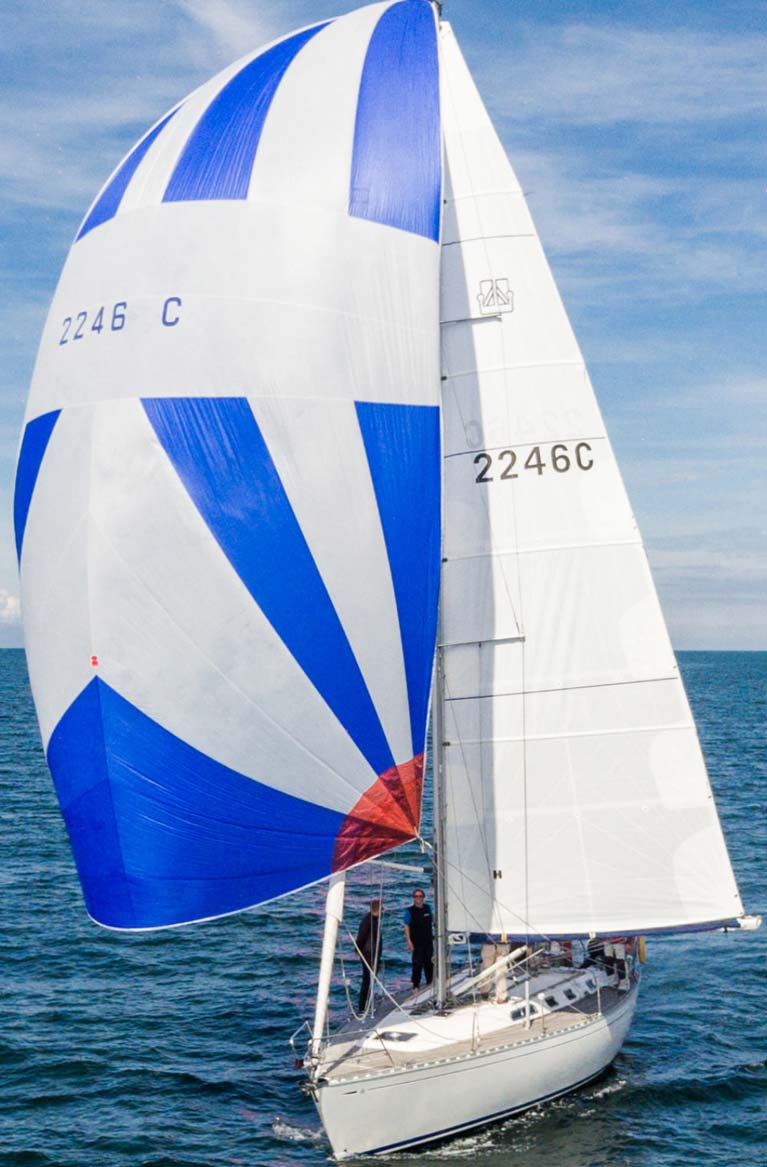 Dufour 41 Classic, Mingulay
Dufour 41 Classic, Mingulay
Four yachts took part. The names will ring a bell with the more senior members of the Irish sailing fraternity; Eamonn Crosbie and the late Jim Poole from Dun Laoghaire in the little Ruffian 23 Ruffino; Brian Law from Strangford Lough with Brian Daniels (ex-Great Britain 11) in Sai See, a 38 ft Finnisterrre class yawl; Robert Mollard and Dick Watson in an S&S 34 Korsar from Dun Laoghaire, and the late Brian Coad and Derek Wyndham’s Folkboat, Shoestring from Waterford. Korsar won in a time of nearly seven days. And Coad won the 1980 race in Raasay of Melfort.
Sadly, Ballyholme let go of the idea and following the success of Wicklow SC’s Round Ireland Rally in 1979, a race starting from and finishing in Wicklow, leaving Ireland and all its islands to starboard, was proposed and under the stewardship of the late Michael Jones, the first Round Ireland took place in 1980.
But Belfast Lough’s association with the race was renewed from time to time. In 1986 Fiona Hicks reminds me that she was part of an all-women crew, which included Enda O’Coineen's sister, Ann Marie Bowring, racing in a Sigma 41 called Electra. And again in 1988, Fiona was in the crew of Twenty Twenty, an MG RS 34 owned by Jimmy Mackey.
 Royal Ulster Yacht Club father and son duo, Johnny and Jamie Ritchie in their Dufour 41 Classic, Mingulay are Round Ireland bound this June
Royal Ulster Yacht Club father and son duo, Johnny and Jamie Ritchie in their Dufour 41 Classic, Mingulay are Round Ireland bound this June
So now the Ritchies are renewing that association, determined to go the distance this year, hopefully without mishap.
In 2018 all began well, and they were mid-fleet between the Tuskar and the Fastnet, but within four hours of rounding the Fastnet in calm conditions at 1800 on 1st July, the wind was gusting 40 knots. They admit they were over canvassed, heeling and taking in water through galley and toilet sinks. They were unaware of the ingress of water as both were in the cockpit. Discretion being the better part of valour, they retired, along with a couple of others to Dingle for repairs. Mingulay did, in fact, complete the passage round Ireland – well nearly – they stopped in Belfast Lough. The father and son hope for better things this time round.
Ballyholme Yacht Club to Host Weekend of Speed in May
Ballyholme Yacht Club will be the venue for the Irish Multihull Association’s Weekend of Speed in mid-May.
The club has extensive experience of hosting national and international sailing events on the virtually tide and hazard free waters of Belfast Lough and it was here in 2014 that the F18 Worlds came to town. Winners then were Gunnar Larsen and Ferdinand van West from the Netherlands. The event also attracted America’s Cup sailor Glenn Ashby (afloat.ie 15/6/14).
So, over the weekend of 23rd and 24th May, the Multihulls will return in numbers, this time hopefully joined by the 49er and 29er fleets, an innovation introduced in 2018. The catamaran fleet race as an Open fleet with Dart 18, Dart16, Hurricane 5.9 SX and a highly competitive F18 fleet.
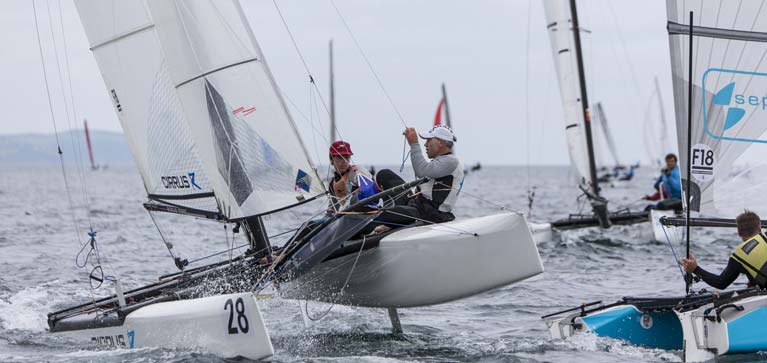
Due to the huge interest and success the event is being developed into an annual meet in association with one of the I.M.A. Regional or National calendar events, this year the Northern Championships.
The organisers welcome any high-performance skiffs with a Portsmouth Number no lower than 900, as well as RS400s, Fireballs and 505s. This could be the event of the year, a chance to see young potential Olympic talent along with Olympians and Olympic contenders on show.
PRO will be International Race Officer, local man, Robin Gray so competitors can be assured of full and fair racing.
A full social programme is planned, and visitors will find smart refurbished and extended changing facilities which include a spacious changing area for disabled people.
There is ample car parking and with the dinghy park extension, plenty of boat space. Camping on site is also available.
Further enquiries to Ballyholme Y.C. +44 (0) 28 9127 1467 or email [email protected], +44 (0)7878 643426.
Great Adventures for Bangor Sea Cadets on Belfast Lough
Among the craft in Bangor Marina on Belfast Lough who have made it their home since it opened thirty years ago, are the rowing boats belonging to the Bangor Sea Cadet Unit, T S Decoy. Their shore base is an ex-Scout hall in Ward Park in the town. The unit’s sailing dinghies are kept at the Outdoor Centre at Killyleagh and the paddleboards at their HQ. Officer in Charge is Philip Atwell.
The Bangor unit has a great record in local and national competition. It prides itself on winning last year, the Sea Cadet burgee with Shamrock as best overall unit in Northern Ireland, and the Amaryllis Trophy for the best sporting unit in the region.
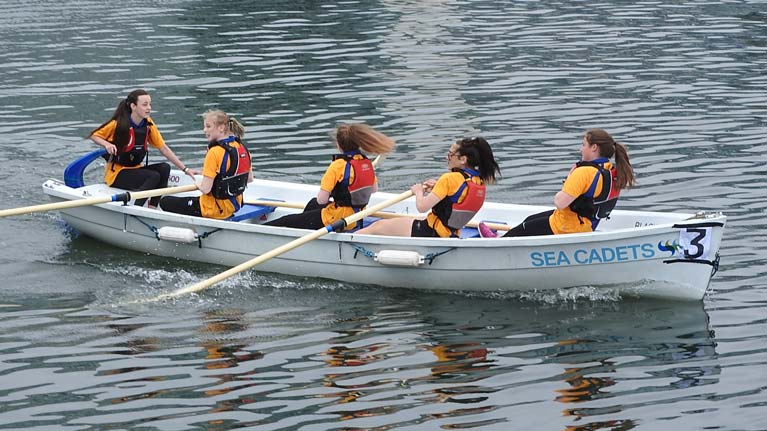 Bangor Sea Cadets Junior girls rowing team winning at the District Regatta
Bangor Sea Cadets Junior girls rowing team winning at the District Regatta
Skilled rowing is high on the trophy list with the under 15 girls’ team winning bronze in London at the national finals. And the unit’s football teams excel also, the under- 15 girls having competed in 5 a-side football, winning Gold in the district competition and bronze in the national competition.
Three of the District team boys took silver. And the junior section cadets (10 - 12-year olds) won bronze in the same competition. A force to be reckoned with.
The 58 strong group, about half of which are girls, is one of several in the region with a total of 380 cadets. The others are Carrickfergus, Larne, Portrush, Belfast (where there are two), Lisburn, Newtownards, Kilkeel, Ballymena, Cookstown and a planned one in Enniskillen.
 Bangor Sea Cadets Girls at a national football competition
Bangor Sea Cadets Girls at a national football competition
The Sea Cadets are a national charity with 400 units across the UK. T S Decoy welcomes “young people to a different kind of adventure. We're helping to launch local young people for life today, transforming them into confident, resilient young people who thrive in a complex world.
Next Steps in Bangor Harbour Regeneration
The regeneration of the waterfront in Bangor as detailed on 25th November in Afloat.ie, reached another crucial stage in its progress when the developer Bangor Marine Ltd. submitted a comprehensive planning application for the site at Queen’s Parade and Marine Gardens overlooking the Marina.
Announcing this next step, the Department for Communities flagged it up as a significant milestone towards seeing the major £50 million regeneration project delivered in the town. Bangor Marine Ltd. is a consortium made up of several leading companies including the Karl Group and Farrans.
 An artist's impression of the new Bangor Harbour area
An artist's impression of the new Bangor Harbour area
The proposed scheme is made up of; Marine Gardens Public Realm combining external events space, cafes, sheltered promenade and kiosks, beach, seafront lawns, children’s play area and water feature, a hotel, a destination/cinema building, residential units, commercial/retail/restaurant space, office space, a play zone, refurbishment of existing commercial properties, basement car park, and marketplace & courtyard squares.
With several key shops quitting the town centre for outlying retail parks and the only shopping centre closing its doors some years ago, it is hoped that this project will go some way to restoring confidence in the town.
Welcoming the application, the Minister for Communities, Deirdre Hargey MLA, said: “This is a huge step in the right direction for the redevelopment of Bangor’s town centre. We are one step closer to the £50 million investment in Bangor, which will create much-needed jobs, shops, offices and homes, and will create an attractive place for people to visit”. She went on to say, “Now that the developer has submitted the Planning Application, I am encouraging everyone in Bangor to get involved, share their ideas, and make their voices heard in the consultation that follows”.
The Mayor of Ards and North Down, Alderman Bill Keery said: “The regeneration of Queen’s Parade is critical to the future of Bangor and working with Council’s plans to help regenerate the Bangor Waterfront will help to maximise the economic growth potential of the wider Borough of Ards and North Down”.
Aran Blackbourne, from Bangor Marine Ltd, said: “We are delighted to submit our exciting plans for the transformation of Queen’s Parade and Marine Gardens in Bangor. Submission of these plans follows a period of extensive and meaningful engagement with Ards and North Down Borough Council, the Department for Communities and, most importantly the people of Bangor.




























